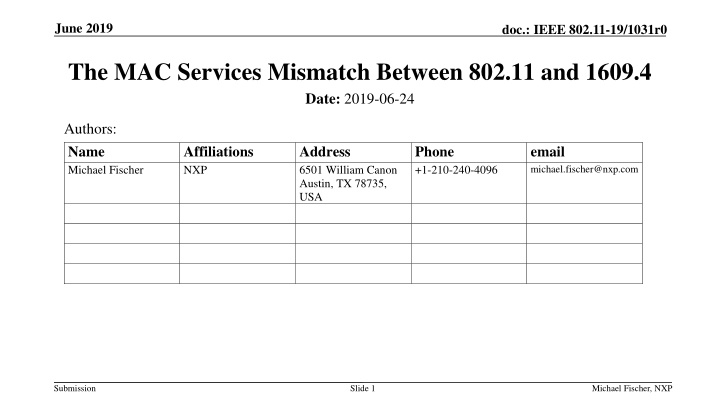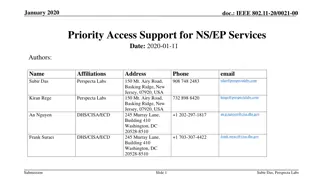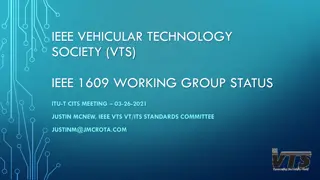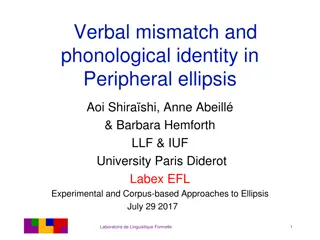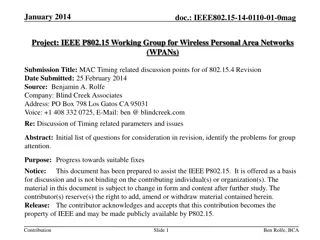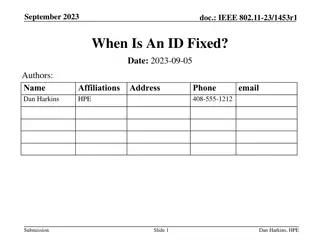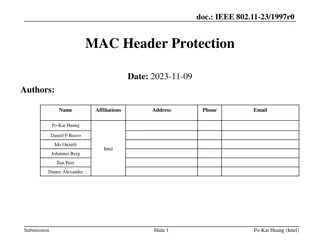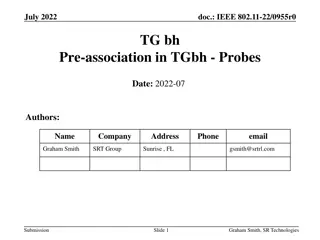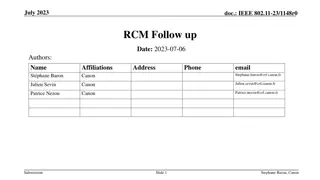IEEE 802.11 and 1609.4 MAC Services Mismatch
IEEE 1609.4 provides MAC services for the upper layers of the WAVE protocol, operating just above the IEEE 802.11 MAC. This document discusses the mismatch in MAC services between IEEE 802.11 and 1609.4, highlighting the unexposed facilities needed by 1609.4. It emphasizes the importance of including extensions to 802.11 MAC services to accommodate the functions required by 1609.4 and other analogous layers of ITS protocol stacks. The comparison of MAC SAP as of 2016 is also presented, along with the functions added by TGbd that will necessitate further SAP exposure.
Download Presentation

Please find below an Image/Link to download the presentation.
The content on the website is provided AS IS for your information and personal use only. It may not be sold, licensed, or shared on other websites without obtaining consent from the author.If you encounter any issues during the download, it is possible that the publisher has removed the file from their server.
You are allowed to download the files provided on this website for personal or commercial use, subject to the condition that they are used lawfully. All files are the property of their respective owners.
The content on the website is provided AS IS for your information and personal use only. It may not be sold, licensed, or shared on other websites without obtaining consent from the author.
E N D
Presentation Transcript
June 2019 doc.: IEEE 802.11-19/1031r0 The MAC Services Mismatch Between 802.11 and 1609.4 Date: 2019-06-24 Authors: Name Michael Fischer Affiliations NXP Address 6501 William Canon Austin, TX 78735, USA Phone +1-210-240-4096 email michael.fischer@nxp.com Submission Slide 1 Michael Fischer, NXP
June 2019 doc.: IEEE 802.11-19/1031r0 Abstract IEEE 1609.4 provides MAC services for the upper layers of the WAVE protocol, operating just above (and partially overlapping with) the IEEE 802.11 MAC operating with dot11OCBActivated = TRUE. Some of the functions that 1609.4 needs to perform require access to facilities that are not exposed at either the 802.11 MAC_SAP or MLME_SAP. The work of TGbd will increase the number of such facilities. Therefore, it is important for TGbd to include extensions to 802.11 MAC services (when dot11OCBActivated = TRUE) that expose the functions needed by 1609 (and the analogous layers of the ITS protocol stacks used in other regulatory domains). Submission Slide 2 Michael Fischer, NXP
June 2019 doc.: IEEE 802.11-19/1031r0 Overview Unexposed MAC facilities needed by 1609.4 today include: Direct selection of many items in the TXVECTOR, including channel, data rate/MCS, and transmit power level, on a per-MSDU basis The ability to specify an expiry time which is the value of the TSF timer at which the MSDU is no longer valid and may be purged by the 802.11 MAC before transmission The ability to change the station s MAC address without resetting the entire MAC Measurement of Channel Busy Percentage, or access to PHY channel status Additional MAC facilities likely to be needed with 802.11bd: Control of the capabilities indicated by the NGV capability indication mechanism Measurement of capabilities indicated by other stations whose transmission are received Access to far more TXVECTOR parameters as well as reporting of RXVECTOR parameters from receptions that are reported upward Submission Slide 3 Michael Fischer, NXP
June 2019 doc.: IEEE 802.11-19/1031r0 Comparison of the MAC_SAP as of 2016 IEEE 802.11-2016 MA-UNITDATA.request (source address, destination address, routing information, data, priority, service class) MA-UNITDATA.indication (source address, destination address, routing information, data, reception status, priority, service class) MA-UNITDATA-STATUS.indication (source address, destination address, transmission status, provided priority, provided service class) IEEE 1609.4-2016 MA-UNITDATAX.request (source address, destination address, routing information, data, priority, service class, Channel Identifier, Time Slot, Data Rate, TxPwr_Level, ExpiryTime) MA-UNITDATA.indication not specified, presumably the 802.11 primitive is used MA-UNITDATAX-STATUS.indication (source address, destination address, transmission status, provided priority, provided service class) Submission Slide 4 Michael Fischer, NXP
June 2019 doc.: IEEE 802.11-19/1031r0 Functions Added by TGbd Needing SAP Exposure The enhanced MAC and PHY functionality being added by TGbd are going to require further extension Selection of MAC enhancements provided by TGbd on a per-MSDU basis Selection of PHY enhancements provided by TGbd on a per-MSDU basis Reporting of optional facilities used to convey received MSDUs Reporting of station capabilities, both for received MSDUs and for stations within RF range whose transmissions are detected but not addressed for reception at this station Submission Slide 5 Michael Fischer, NXP
June 2019 doc.: IEEE 802.11-19/1031r0 Comparison of the MLME_SAP as of 2016 IEEE 802.11-2016 The subset of 802.11 MLME primitives explicitly listed in 1609.4 are: MLME-GET MLME-SET MLME-TIMING_ADVERTISEMENT MLME-GETTSFTIME IEEE 1609.4-2016 MLME extension primitives specified in 1609.4: MLMEX-TA / MLMEX-TAEND MLMEX-CHSTART / MLMEX-CHEND MLMEX-REGISTERTXPROFILE / MLMEX- DELETETXPROFILE MLMEX-CANCELTX MLMEX-GETUTCTIME MLMEX-AddressChange MLMEX-SendPrimitive The primitives in bold appear to require support within the MAC Submission Slide 6 Michael Fischer, NXP
May 2019 doc.: IEEE 802.11-19/1031r0 Extending the MAC Data Service Primitives (after 11-19/0276r4) The best way to extend MAC Data Service is to define a new, NGV-specific parameter to each of the MAC Data Service primitives: MA-UNITDATA.request (source address, destination address, routing information, data, priority, service class, radio environment request vector) MA-UNITDATA.indication (source address, destination address, routing information, data, reception status, priority, service class, radio environment status vector) MA-UNITDATA-STATUS.indication (source address, destination address, transmission status, provided priority, provided service class, radio environment status vector) A radio environment {request/status} vector parameter shall be present when dot11OCBActivated is TRUE and absent otherwise. By defining the new parameter as a vector, and describing the elements of these vectors in separate sub-clauses, the editorial impact on existing clause 5 text is minimized. Submission Slide 7 Fischer - Filippi - Martinez, NXP
May 2019 doc.: IEEE 802.11-19/1031r0 Radio Environment Request Vector Contents (after 11-19/0276r4) The Radio Environment Request Vector allows the higher layers to control the format, encoding, and MPDU handling for the 802.11bd transmission The elements of the Radio Environment Request Vector include: Transmission format (legacy/NGV, data rate/MCS, repetitions, etc.) Coding alternatives (BCC, LDPC, etc.) Spatial stream alternatives (MIMO, STBC, etc.) Aggregation alternatives PHY alternatives (band, channel, transmit power level, etc.) Expiry time (time after which this MSDU is discarded if not transmitted) whatever else needs to be controlled within the NGV MAC and PHY functionality) A value that permits selection within the MAC should exist for each element Submission Slide 8 Fischer - Filippi - Martinez, NXP
May 2019 doc.: IEEE 802.11-19/1031r0 Radio Environment Status Vector Contents (after 11-19/0276r4) The Radio Environment Status Vector provides to the higher layers status about the current radio environment and the most recent 802.11bd reception The elements of the Radio Environment Status Vector include: Transmission format used (legacy/NGV, data rate/MCS) Coding alternatives used (BCC, LDPC, etc.) Spatial stream alternatives used (MIMO, STBC, etc.) PHY alternatives used (band, channel, etc.) Submission Slide 9 Fischer - Filippi - Martinez, NXP
June 2019 doc.: IEEE 802.11-19/1031r0 Reporting of Radio Environment Characteristics The characteristics of the radio environment are reported on a periodic basis, independent of receptions of MSDUs, so ought to be reported separately MA-RADIOENVIRONMENT.indication (Channel Busy Percentage, Capability Percentage, Station Count) Channel Busy Percentage as already defined in IEEE 1609 Capability Percentage proposed (as TechPercentage ) in 11-19/0783 Station Count number of stations detected during most recent measurement period of Channel Busy Percentage and Capability Percentage Submission Slide 10 Michael Fischer, NXP
May 2019 doc.: IEEE 802.11-19/1031r0 MLME SAP Extension IEEE 1609.4 includes a set of primitives extending the MLME_SAP. These appear as MLMEX-primitives in Clause 7 of IEEE 1609.4-2016 As a minimum, the MLME_SAP in 802.11bd should include a request/confirm primitive pair that corresponds to MLMEX-AddressChange It is recommended strongly that the MLME_SAP in 802.11bd include a generic means for the MAC at an NGV station to accept additional, ITS-related management primitives It is unclear whether 802.11bd should include the full set of MLMEX primitives The exact set of extensions required vary with regional ITS standards The functions of the various regional MLME extensions should probably remain in the higher- layer standards documents, rather than having redundant definitions in documents that are maintained by different organizations, and are updated according to different schedules Defining the full set of MLMEX primitives will also necessitate adding quite a bit of normative text elsewhere in the MAC that may complicate and/or delay the work of TGbd Submission Slide 11 Fischer - Filippi - Martinez, NXP
May 2019 doc.: IEEE 802.11-19/1031r0 Additional Attributes in 802.11bd MIB Some of the NGV-specific parameter values are static, and can be managed as MIB attributes rather than service primitive parameters at the MAC or MLME SAPs. These include: NGV activation (the NGV equivalent of dot11OCBactivated) NGV capabilities (to be indicated in transmissions from this station) NGV bands supported Measurement interval for ChannelBusyPercentage (default value 100ms) ChannelBusyPercentage smoothing parameters (to accommodate CBR/CBP differences) Measurement interval for TechPercentage (default value 1000ms) Submission Slide 12 Fischer - Filippi - Martinez, NXP
